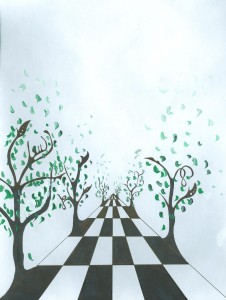week six – from the ground up
May 8th, 2014 by lydiachenIn this week’s creative response, I tried to conceptualize and visualize some of S.H. Nasr’s arguments about religious spaces in Islamic Art and Spirituality (although this attempt may be, in and of itself, somewhat contradictory to his ideas). One of the fundamental parts of a religious space, Nasr argues, is the ground:
The carpet, whether of simple white colour or full of geometric and arabesque patterns and ornaments, reflects Heaven (Nasr 39).
In my work, the ground is the starting point for the growth of spirituality and inner knowledge. Trees, calligraphy, and Islamic arabesques sprout from the floor. As forms of Islamic art, Nasr argues that all of these things take root in an an archetypal reality. Each tree, as a manifestation of these realities, is different but still takes on certain spiritual aspects in the form of divinely inspired calligraphy and geometric form.
However, space also plays an important role in Nasr’s ideas of Islamic Art. I found the interplay of unity and multiplicity particularly interesting in his writings.
Islamic art is the result of the manifestation of unity upon the plane of multiplicity (Nasr 7).
During my research for this post I came across the Vanishing Mosque in the United Arab Emirates. This innovative space combines mosque and public plaza to reflect the increasing integration of religious and urban life. In the same way, I wanted to create a work that defies conventional ideas of space. Playing with optical illusion and vanishing point perspective, we can visualize the multidimensional on a single sheet of paper, the living on the static, the many in the one.
It is true that this painting is likely not what Nasr had in mind when defining Islamic art. And although I continue to struggle with what truly defines Islamic art from other religious or secular art, I do agree with Nasr that in some ways Islam defines its own art. Ultimately, what matters is not the arabesque, geometric form or Arabic script — all of these specific shapes fade away. The truth in Islamic Art is not in specificity, but in unity, and the realization that many forms can reflect one reality.
Medium: Acrylic Paint
